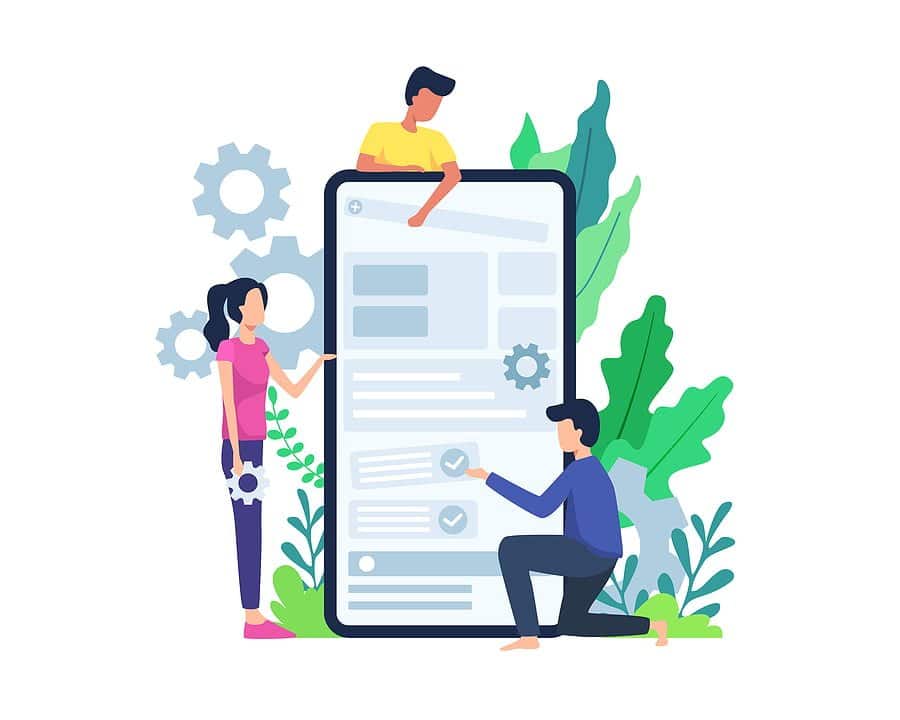Trending app ideas for you to explore.
As the global markets emerge from the economic downturn caused by the coronavirus pandemic, companies start to awaken to a new reality. For businesses across industries, building an online presence has become critical to survival. The trends in app development are also changing in line with customer needs and expectations.
In this article, we will list some of the most prominent trending app ideas and offer you app development tips that you may find useful.

Best App Ideas for 2021 and Beyond
Intensive use of social media and increased consumption of content, the decline in luxury goods sales, online shopping, and the soaring demand for remote healthcare; are some of the indications of changing consumer habits. The amount of time an average person spends using their smartphones has also increased, and fresh mobile app ideas are becoming highly relevant. Let’s now take a closer look at some of the newly emerging trends in app development.
Trending App Ideas: Freelancing marketplaces
If you’re looking for ways to expand your business into a new area, create your own online marketplace. Skyrocketing unemployment rates, new employee strategies and remote work are quickly becoming the new normal, and have set the stage for the emergence of new freelance marketplaces and platforms. Under the new circumstances, online marketplace platforms like Upwork, connecting customers with teams and freelancers, have all of a sudden become investment magnets.
On-demand delivery apps
On-demand local delivery apps are on the rise, given that people are wary of going out and some world regions haven’t yet fully recovered from the COVID-19 pandemic. As a fast, cheap, and transparent way of receiving consumer goods, on-demand delivery is not only attractive to customers but also offers struggling businesses a means to stay afloat. On top of that, on-demand food delivery apps enable companies to never lose touch with their clients, even if the lockdown prevents them from visiting physical venues.
Doctor-on-demand apps
The trend for doctor-on-demand apps has been on the rise long before the pandemic – the world’s aging population and the growing number of people living in rural areas have brought forth the spread of mobile doctor apps. In the midst of the COVID-19 outbreak, doctor-on-demand solutions enabled doctors and patients to communicate from the safety of their homes.
Other benefits of telemedicine app development include saving patients’ travel time and expenses and extending the choice of healthcare professionals. For doctors, maintaining ongoing practice during the lockdown, increased exposure, and better work-life balance are some of the tangible advantages of telemedicine apps.
Virtual communication and collaboration tools
Having recognized the benefits of remote work, many businesses have shifted, fully or partially, into a work-from-home model. This means a heightened demand for tools for remote collaboration and communication. As the example of the Zoom platform suggests, an application can quickly increase in the number of its subscribers, if it offers users exactly what they need. As such, tools for remote collaboration range from video-conferencing for in-person and team meetings, to complex project management suites with task scheduling and time tracking.
Trending App Ideas: The IoT-powered solutions
Although adversely affected during the pandemic, the Internet of Things market is predicted to grow steadily as the economy starts to recover. In fact, IoT is set to become the main driving force behind the growth of industrial automation and control systems markets by 2027. The demands for employee security and the need to bring organization processes to unified standards are contributing to faster IoT adoption. Most experts agree that the manufacturing and healthcare industries will leave other market segments far behind when it comes to adopting IoT solutions.
Edtech and remote education solutions
The measures taken to curb the pandemic have led to the spread of homeschooling and remote education with edtech (i.e. education technology) as the main driving force behind these practices. Although in-person education remains highly relevant, edtech offers both learners and educators a number of tangible benefits such as increased accessibility, a personalized approach, precise and unbiased knowledge assessment and inclusion. Right now, edtech apps are transforming the classroom experience, and are some of the biggest trends in today’s app development.

A Guide to Building Apps from Scratch
How to develop an app from scratch and build an online presence may seem like an insurmountable task, especially, if you’ve previously run a traditional business. Below are some of the most useful tips for successful app development to set you on the right track.
1. Brainstorm app ideas
Every app starts with the idea, but if you’re not especially creative, adopting a customer-centric approach will surely help you come up with something attention-worthy. Think about the problems your customers face, their concerns, and the most frequently asked customer support questions. How will your future app help customers solve their pressing problems?
2. Identify your competitors
If you need to know how to develop an app idea, take a closer look at other apps on the market. Knowing your competitors will also help you come up with an app that truly stands out. Your direct competitors will have similar offerings, while the apps of your indirect competitors will have at least some functions that could help users achieve the same goal. Learn which features these apps lack and include them in your app. The ‘look and feel’ can also be a competitive advantage. Look at your competitors’ UI and try to offer customers a better user experience.
3. Choose your business model
What is your app monetization strategy? Simply put, how will you earn money with your app? There are several business models that you may implement; in-app purchases, third-party ads, or a subscription model. You may also build your app in a paid-only version if you’re sure your offering is truly unique. It is important that you choose your business model before you start the application development since the app’s function and architecture will depend on it.
4. Finalize your requirements
This will be the initial step of your product discovery phase. You will have to present all the functional and non-functional requirements for your app in a document, written in a clear and comprehensive form. By functional requirements, we mean concrete features and functions, for example, scheduling and rescheduling appointments in a doctor-on-demand app. Non-functional requirements include features like security, cross-platform availability, scalability, and performance. As the developers start building your product, this document will serve as an important guide.
5. Visualize your concept
The purpose of building a prototype version of your app is to evaluate how the market, stakeholders, and investors respond to your idea and to fine-tune it in line with the response you receive. Visualization and prototyping helps you quickly get feedback without spending months on end-product development. It also has a marketing function and helps you create a pool of customers potentially interested in your app.
As such, a prototype can be pretty basic. Even a simple visualization of a user interface can help you collect some primary feedback.
6. Start app development and testing
As you develop, don’t forget to include continuous testing into the app-building lifecycle. Today’s best app development methodologies include on-going improvement and regular consultations with the client in order to reduce time-to-market and ensure that the app meets the requirements and specifications. Needless to say, your end-product may only vaguely resemble your initial idea, due to all the improvements you introduce in the process.
Testing your app with the early adopters will help you reveal and eliminate any of the app’s shortcomings and allow you to prepare for the final product launch.
8. Launch
As simple as it may seem, a successful app launch will require careful preparation and a set of marketing activities targeted at building your app’s audience and promoting your app. The critical part is optimizing your app for search results in App stores and ensuring that users can easily find it by entering the relevant keywords. Attractive visuals and early user testimonials will also help you promote your app.
9. Measure, improve and scale
Once your app is out on the App Store, you will have to stay committed to its constant upgrade and improvement. This will require monitoring app performance and measuring the quality of user experience. The key usability metrics to monitor are success rate, touch heatmaps, number of errors, and time-based efficiency.
Also, make sure to track marketing metrics such as app downloads, user retention rate and churn rate, the number of daily and monthly active users, cost per acquisition rates. Etc.
These indicators as well as the technical metrics such as app speed, latency and CPU usage will help you evaluate the overall success of your application, determine if you need to scale it to accommodate more users, and which new features you need to introduce.
Final Thoughts
Although the COVID-19 crisis has disrupted many industries and put an end to the world as we knew it, the new trends in app development are already shaping up. Digitization is the name of the game: currently, it’s what companies need to thrive in the new reality. For companies that have been long postponing the digitization of their business, the time is ripe to act and build a digital and online presence.





